Comparing HRM Practices of MNCs Operating in Different Nations
VerifiedAdded on 2022/11/26
|10
|3554
|385
Essay
AI Summary
This essay delves into the intricacies of International Human Resource Management (IHRM), focusing on the diverse HRM practices adopted by Multinational Corporations (MNCs) when operating in different nations. The essay begins by defining HRM and IHRM, highlighting the key differences and similarities between domestic and international HRM, including staffing, planning, selection, recruitment, and development. The discussion then examines the impact of globalization and the challenges associated with managing employees from diverse backgrounds, emphasizing the importance of adapting HRM practices to local contexts. A significant portion of the essay addresses the country of origin effect, exploring how an MNC's home country influences its HRM strategies in foreign subsidiaries, with examples from American, Japanese, and European companies. It discusses the transplantation, mixed, and localization strategies. Cross-cultural management is another important focus, with an overview of Hofstede's cultural dimensions (power distance, individualism vs. collectivism, etc.) and their implications for HRM. The essay also includes a case study of Coca-Cola and its global approach, offering real-world examples of how companies navigate the complexities of IHRM. The overall argument emphasizes the need for MNCs to understand and adapt their HRM practices to the unique cultural, legal, and economic environments of the countries in which they operate to achieve organizational success.
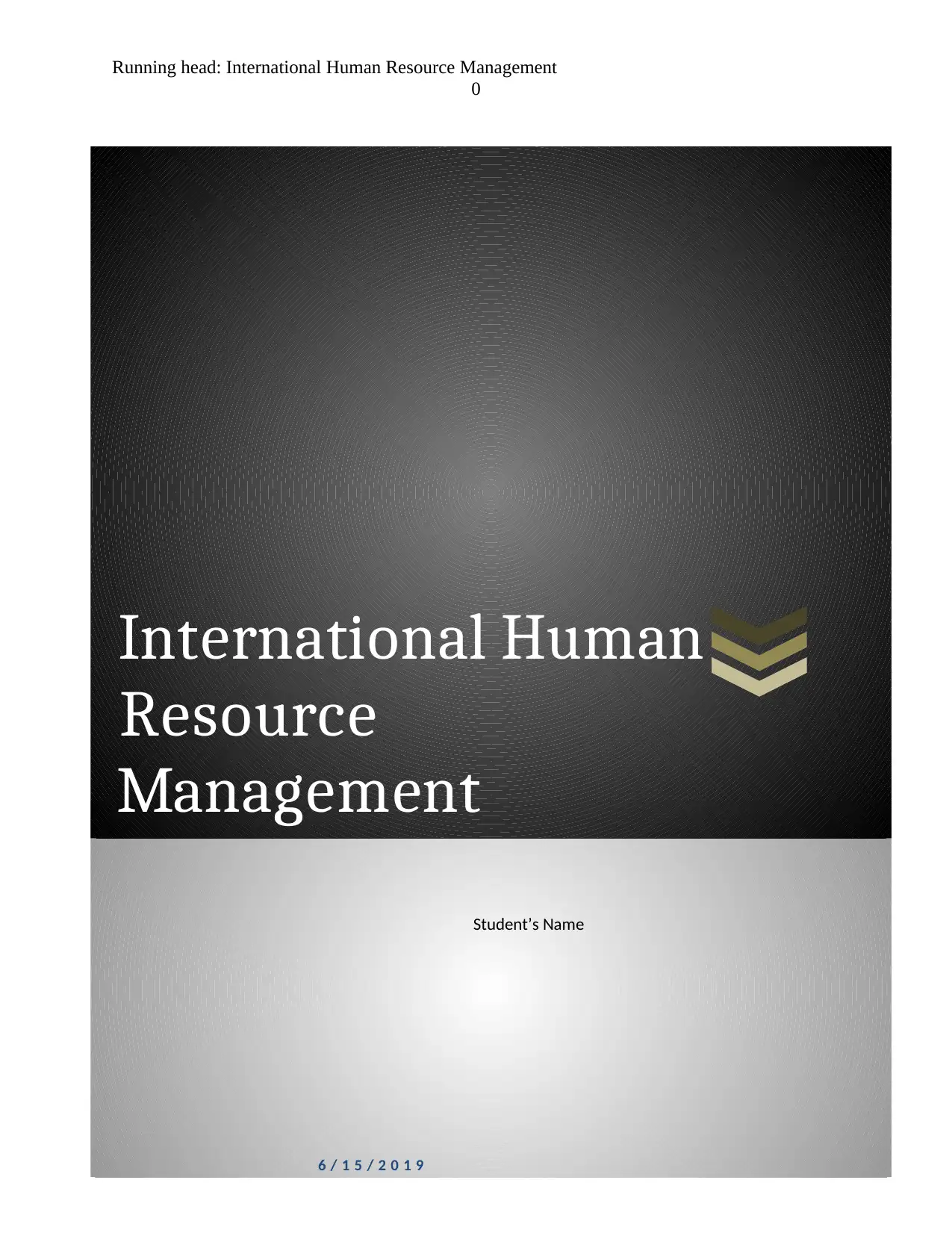
International Human
Resource
Management
Running head: International Human Resource Management
0
6 / 1 5 / 2 0 1 9
Student’s Name
Resource
Management
Running head: International Human Resource Management
0
6 / 1 5 / 2 0 1 9
Student’s Name
Paraphrase This Document
Need a fresh take? Get an instant paraphrase of this document with our AI Paraphraser
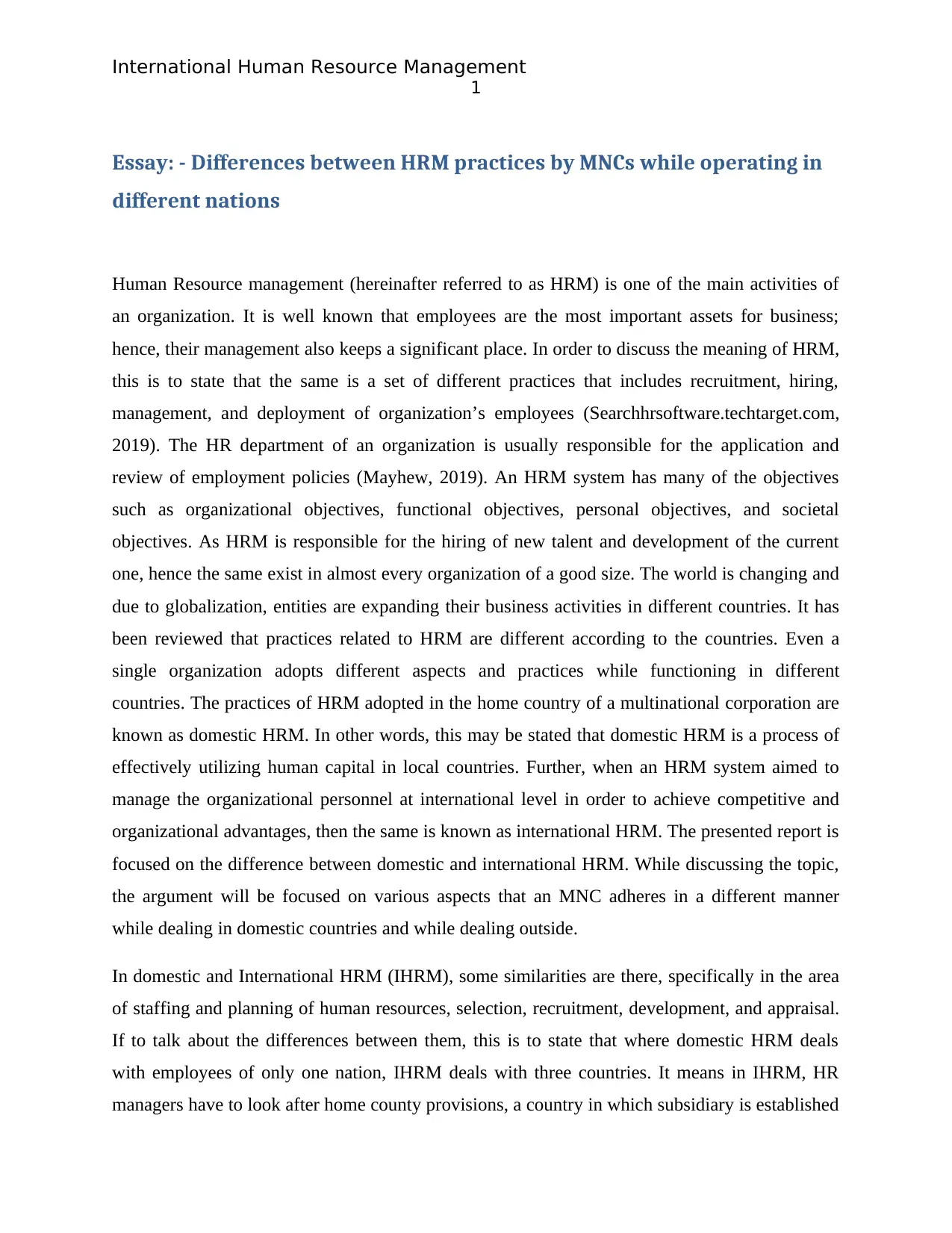
International Human Resource Management
1
Essay: - Differences between HRM practices by MNCs while operating in
different nations
Human Resource management (hereinafter referred to as HRM) is one of the main activities of
an organization. It is well known that employees are the most important assets for business;
hence, their management also keeps a significant place. In order to discuss the meaning of HRM,
this is to state that the same is a set of different practices that includes recruitment, hiring,
management, and deployment of organization’s employees (Searchhrsoftware.techtarget.com,
2019). The HR department of an organization is usually responsible for the application and
review of employment policies (Mayhew, 2019). An HRM system has many of the objectives
such as organizational objectives, functional objectives, personal objectives, and societal
objectives. As HRM is responsible for the hiring of new talent and development of the current
one, hence the same exist in almost every organization of a good size. The world is changing and
due to globalization, entities are expanding their business activities in different countries. It has
been reviewed that practices related to HRM are different according to the countries. Even a
single organization adopts different aspects and practices while functioning in different
countries. The practices of HRM adopted in the home country of a multinational corporation are
known as domestic HRM. In other words, this may be stated that domestic HRM is a process of
effectively utilizing human capital in local countries. Further, when an HRM system aimed to
manage the organizational personnel at international level in order to achieve competitive and
organizational advantages, then the same is known as international HRM. The presented report is
focused on the difference between domestic and international HRM. While discussing the topic,
the argument will be focused on various aspects that an MNC adheres in a different manner
while dealing in domestic countries and while dealing outside.
In domestic and International HRM (IHRM), some similarities are there, specifically in the area
of staffing and planning of human resources, selection, recruitment, development, and appraisal.
If to talk about the differences between them, this is to state that where domestic HRM deals
with employees of only one nation, IHRM deals with three countries. It means in IHRM, HR
managers have to look after home county provisions, a country in which subsidiary is established
1
Essay: - Differences between HRM practices by MNCs while operating in
different nations
Human Resource management (hereinafter referred to as HRM) is one of the main activities of
an organization. It is well known that employees are the most important assets for business;
hence, their management also keeps a significant place. In order to discuss the meaning of HRM,
this is to state that the same is a set of different practices that includes recruitment, hiring,
management, and deployment of organization’s employees (Searchhrsoftware.techtarget.com,
2019). The HR department of an organization is usually responsible for the application and
review of employment policies (Mayhew, 2019). An HRM system has many of the objectives
such as organizational objectives, functional objectives, personal objectives, and societal
objectives. As HRM is responsible for the hiring of new talent and development of the current
one, hence the same exist in almost every organization of a good size. The world is changing and
due to globalization, entities are expanding their business activities in different countries. It has
been reviewed that practices related to HRM are different according to the countries. Even a
single organization adopts different aspects and practices while functioning in different
countries. The practices of HRM adopted in the home country of a multinational corporation are
known as domestic HRM. In other words, this may be stated that domestic HRM is a process of
effectively utilizing human capital in local countries. Further, when an HRM system aimed to
manage the organizational personnel at international level in order to achieve competitive and
organizational advantages, then the same is known as international HRM. The presented report is
focused on the difference between domestic and international HRM. While discussing the topic,
the argument will be focused on various aspects that an MNC adheres in a different manner
while dealing in domestic countries and while dealing outside.
In domestic and International HRM (IHRM), some similarities are there, specifically in the area
of staffing and planning of human resources, selection, recruitment, development, and appraisal.
If to talk about the differences between them, this is to state that where domestic HRM deals
with employees of only one nation, IHRM deals with three countries. It means in IHRM, HR
managers have to look after home county provisions, a country in which subsidiary is established
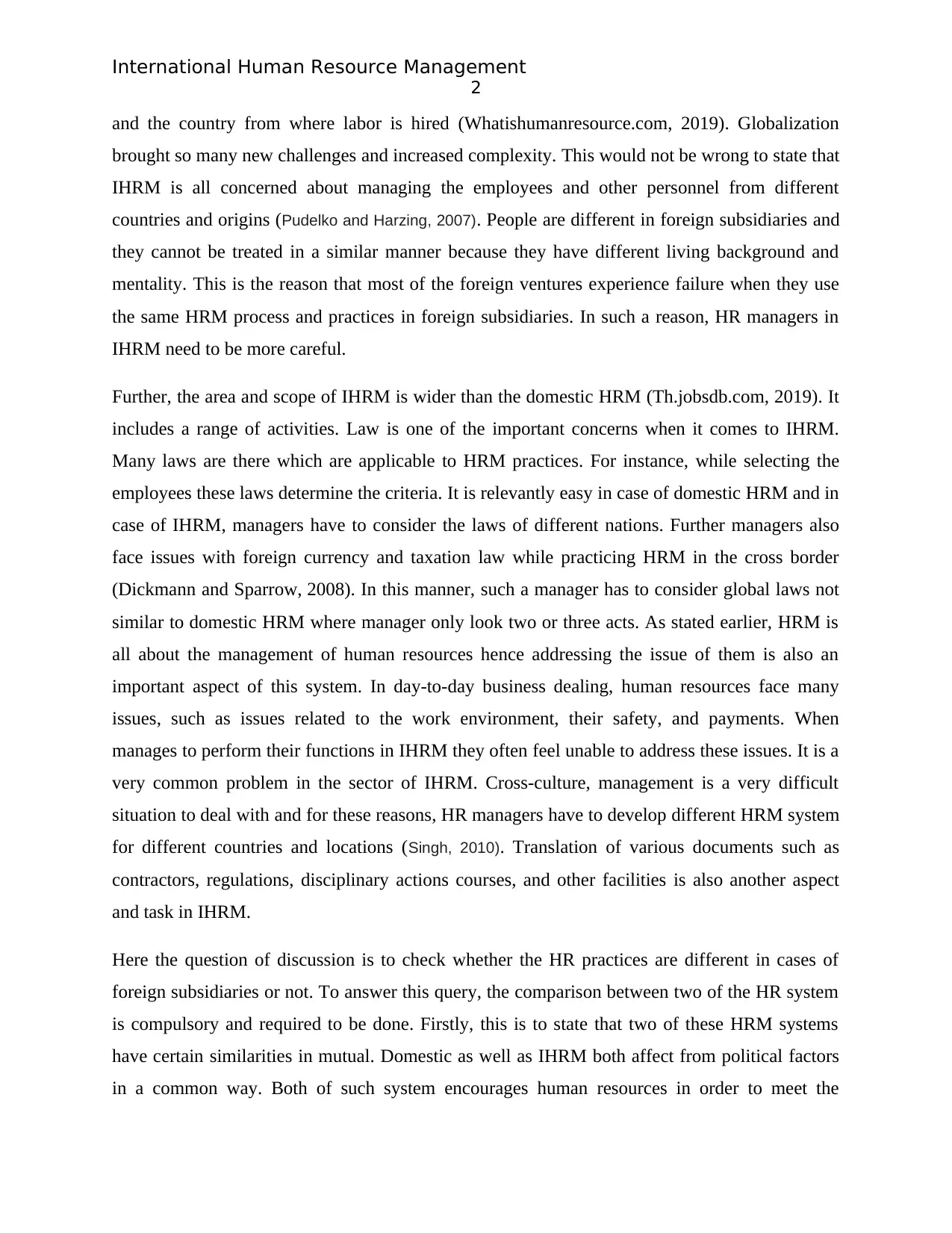
International Human Resource Management
2
and the country from where labor is hired (Whatishumanresource.com, 2019). Globalization
brought so many new challenges and increased complexity. This would not be wrong to state that
IHRM is all concerned about managing the employees and other personnel from different
countries and origins (Pudelko and Harzing, 2007). People are different in foreign subsidiaries and
they cannot be treated in a similar manner because they have different living background and
mentality. This is the reason that most of the foreign ventures experience failure when they use
the same HRM process and practices in foreign subsidiaries. In such a reason, HR managers in
IHRM need to be more careful.
Further, the area and scope of IHRM is wider than the domestic HRM (Th.jobsdb.com, 2019). It
includes a range of activities. Law is one of the important concerns when it comes to IHRM.
Many laws are there which are applicable to HRM practices. For instance, while selecting the
employees these laws determine the criteria. It is relevantly easy in case of domestic HRM and in
case of IHRM, managers have to consider the laws of different nations. Further managers also
face issues with foreign currency and taxation law while practicing HRM in the cross border
(Dickmann and Sparrow, 2008). In this manner, such a manager has to consider global laws not
similar to domestic HRM where manager only look two or three acts. As stated earlier, HRM is
all about the management of human resources hence addressing the issue of them is also an
important aspect of this system. In day-to-day business dealing, human resources face many
issues, such as issues related to the work environment, their safety, and payments. When
manages to perform their functions in IHRM they often feel unable to address these issues. It is a
very common problem in the sector of IHRM. Cross-culture, management is a very difficult
situation to deal with and for these reasons, HR managers have to develop different HRM system
for different countries and locations (Singh, 2010). Translation of various documents such as
contractors, regulations, disciplinary actions courses, and other facilities is also another aspect
and task in IHRM.
Here the question of discussion is to check whether the HR practices are different in cases of
foreign subsidiaries or not. To answer this query, the comparison between two of the HR system
is compulsory and required to be done. Firstly, this is to state that two of these HRM systems
have certain similarities in mutual. Domestic as well as IHRM both affect from political factors
in a common way. Both of such system encourages human resources in order to meet the
2
and the country from where labor is hired (Whatishumanresource.com, 2019). Globalization
brought so many new challenges and increased complexity. This would not be wrong to state that
IHRM is all concerned about managing the employees and other personnel from different
countries and origins (Pudelko and Harzing, 2007). People are different in foreign subsidiaries and
they cannot be treated in a similar manner because they have different living background and
mentality. This is the reason that most of the foreign ventures experience failure when they use
the same HRM process and practices in foreign subsidiaries. In such a reason, HR managers in
IHRM need to be more careful.
Further, the area and scope of IHRM is wider than the domestic HRM (Th.jobsdb.com, 2019). It
includes a range of activities. Law is one of the important concerns when it comes to IHRM.
Many laws are there which are applicable to HRM practices. For instance, while selecting the
employees these laws determine the criteria. It is relevantly easy in case of domestic HRM and in
case of IHRM, managers have to consider the laws of different nations. Further managers also
face issues with foreign currency and taxation law while practicing HRM in the cross border
(Dickmann and Sparrow, 2008). In this manner, such a manager has to consider global laws not
similar to domestic HRM where manager only look two or three acts. As stated earlier, HRM is
all about the management of human resources hence addressing the issue of them is also an
important aspect of this system. In day-to-day business dealing, human resources face many
issues, such as issues related to the work environment, their safety, and payments. When
manages to perform their functions in IHRM they often feel unable to address these issues. It is a
very common problem in the sector of IHRM. Cross-culture, management is a very difficult
situation to deal with and for these reasons, HR managers have to develop different HRM system
for different countries and locations (Singh, 2010). Translation of various documents such as
contractors, regulations, disciplinary actions courses, and other facilities is also another aspect
and task in IHRM.
Here the question of discussion is to check whether the HR practices are different in cases of
foreign subsidiaries or not. To answer this query, the comparison between two of the HR system
is compulsory and required to be done. Firstly, this is to state that two of these HRM systems
have certain similarities in mutual. Domestic as well as IHRM both affect from political factors
in a common way. Both of such system encourages human resources in order to meet the
⊘ This is a preview!⊘
Do you want full access?
Subscribe today to unlock all pages.

Trusted by 1+ million students worldwide
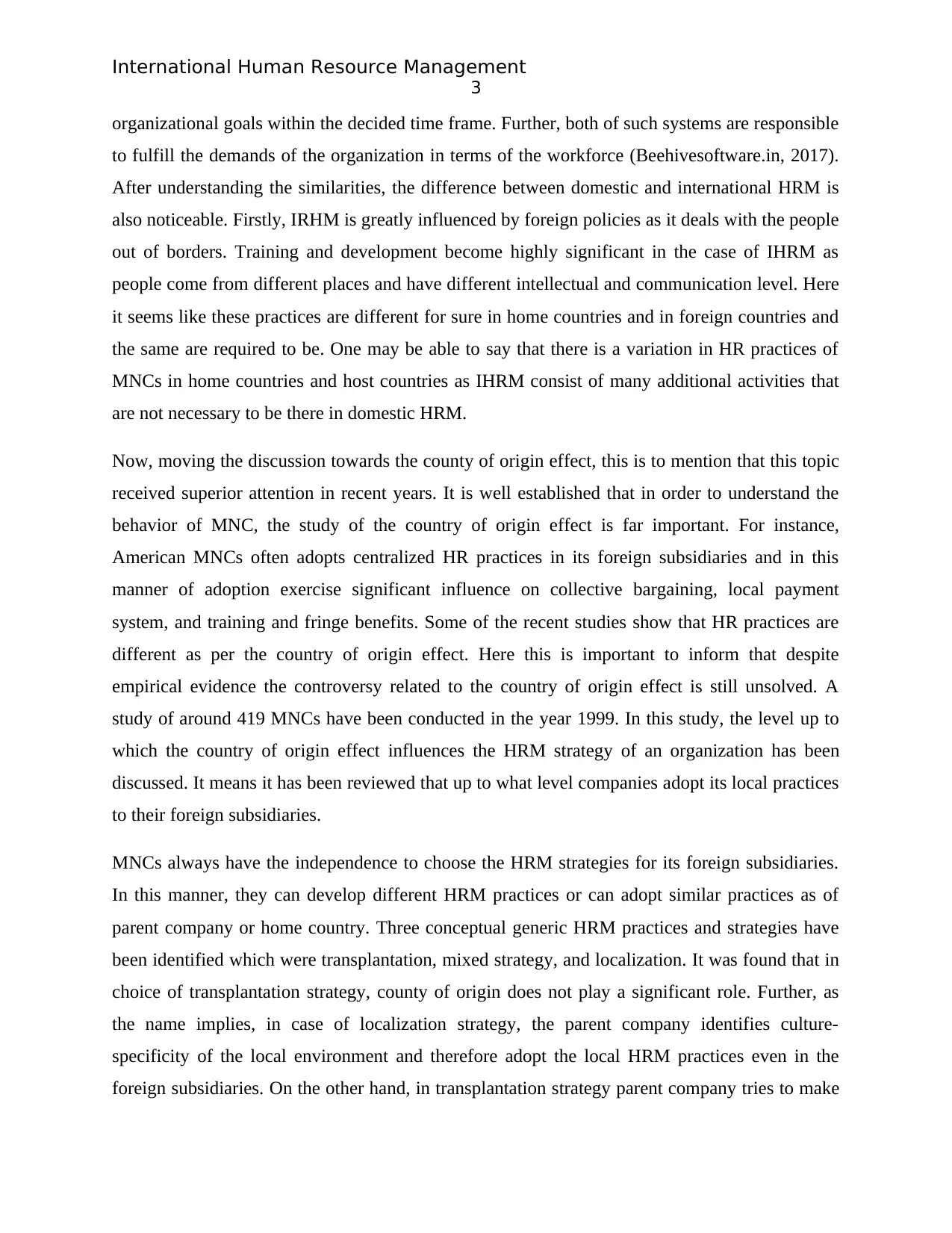
International Human Resource Management
3
organizational goals within the decided time frame. Further, both of such systems are responsible
to fulfill the demands of the organization in terms of the workforce (Beehivesoftware.in, 2017).
After understanding the similarities, the difference between domestic and international HRM is
also noticeable. Firstly, IRHM is greatly influenced by foreign policies as it deals with the people
out of borders. Training and development become highly significant in the case of IHRM as
people come from different places and have different intellectual and communication level. Here
it seems like these practices are different for sure in home countries and in foreign countries and
the same are required to be. One may be able to say that there is a variation in HR practices of
MNCs in home countries and host countries as IHRM consist of many additional activities that
are not necessary to be there in domestic HRM.
Now, moving the discussion towards the county of origin effect, this is to mention that this topic
received superior attention in recent years. It is well established that in order to understand the
behavior of MNC, the study of the country of origin effect is far important. For instance,
American MNCs often adopts centralized HR practices in its foreign subsidiaries and in this
manner of adoption exercise significant influence on collective bargaining, local payment
system, and training and fringe benefits. Some of the recent studies show that HR practices are
different as per the country of origin effect. Here this is important to inform that despite
empirical evidence the controversy related to the country of origin effect is still unsolved. A
study of around 419 MNCs have been conducted in the year 1999. In this study, the level up to
which the country of origin effect influences the HRM strategy of an organization has been
discussed. It means it has been reviewed that up to what level companies adopt its local practices
to their foreign subsidiaries.
MNCs always have the independence to choose the HRM strategies for its foreign subsidiaries.
In this manner, they can develop different HRM practices or can adopt similar practices as of
parent company or home country. Three conceptual generic HRM practices and strategies have
been identified which were transplantation, mixed strategy, and localization. It was found that in
choice of transplantation strategy, county of origin does not play a significant role. Further, as
the name implies, in case of localization strategy, the parent company identifies culture-
specificity of the local environment and therefore adopt the local HRM practices even in the
foreign subsidiaries. On the other hand, in transplantation strategy parent company tries to make
3
organizational goals within the decided time frame. Further, both of such systems are responsible
to fulfill the demands of the organization in terms of the workforce (Beehivesoftware.in, 2017).
After understanding the similarities, the difference between domestic and international HRM is
also noticeable. Firstly, IRHM is greatly influenced by foreign policies as it deals with the people
out of borders. Training and development become highly significant in the case of IHRM as
people come from different places and have different intellectual and communication level. Here
it seems like these practices are different for sure in home countries and in foreign countries and
the same are required to be. One may be able to say that there is a variation in HR practices of
MNCs in home countries and host countries as IHRM consist of many additional activities that
are not necessary to be there in domestic HRM.
Now, moving the discussion towards the county of origin effect, this is to mention that this topic
received superior attention in recent years. It is well established that in order to understand the
behavior of MNC, the study of the country of origin effect is far important. For instance,
American MNCs often adopts centralized HR practices in its foreign subsidiaries and in this
manner of adoption exercise significant influence on collective bargaining, local payment
system, and training and fringe benefits. Some of the recent studies show that HR practices are
different as per the country of origin effect. Here this is important to inform that despite
empirical evidence the controversy related to the country of origin effect is still unsolved. A
study of around 419 MNCs have been conducted in the year 1999. In this study, the level up to
which the country of origin effect influences the HRM strategy of an organization has been
discussed. It means it has been reviewed that up to what level companies adopt its local practices
to their foreign subsidiaries.
MNCs always have the independence to choose the HRM strategies for its foreign subsidiaries.
In this manner, they can develop different HRM practices or can adopt similar practices as of
parent company or home country. Three conceptual generic HRM practices and strategies have
been identified which were transplantation, mixed strategy, and localization. It was found that in
choice of transplantation strategy, county of origin does not play a significant role. Further, as
the name implies, in case of localization strategy, the parent company identifies culture-
specificity of the local environment and therefore adopt the local HRM practices even in the
foreign subsidiaries. On the other hand, in transplantation strategy parent company tries to make
Paraphrase This Document
Need a fresh take? Get an instant paraphrase of this document with our AI Paraphraser
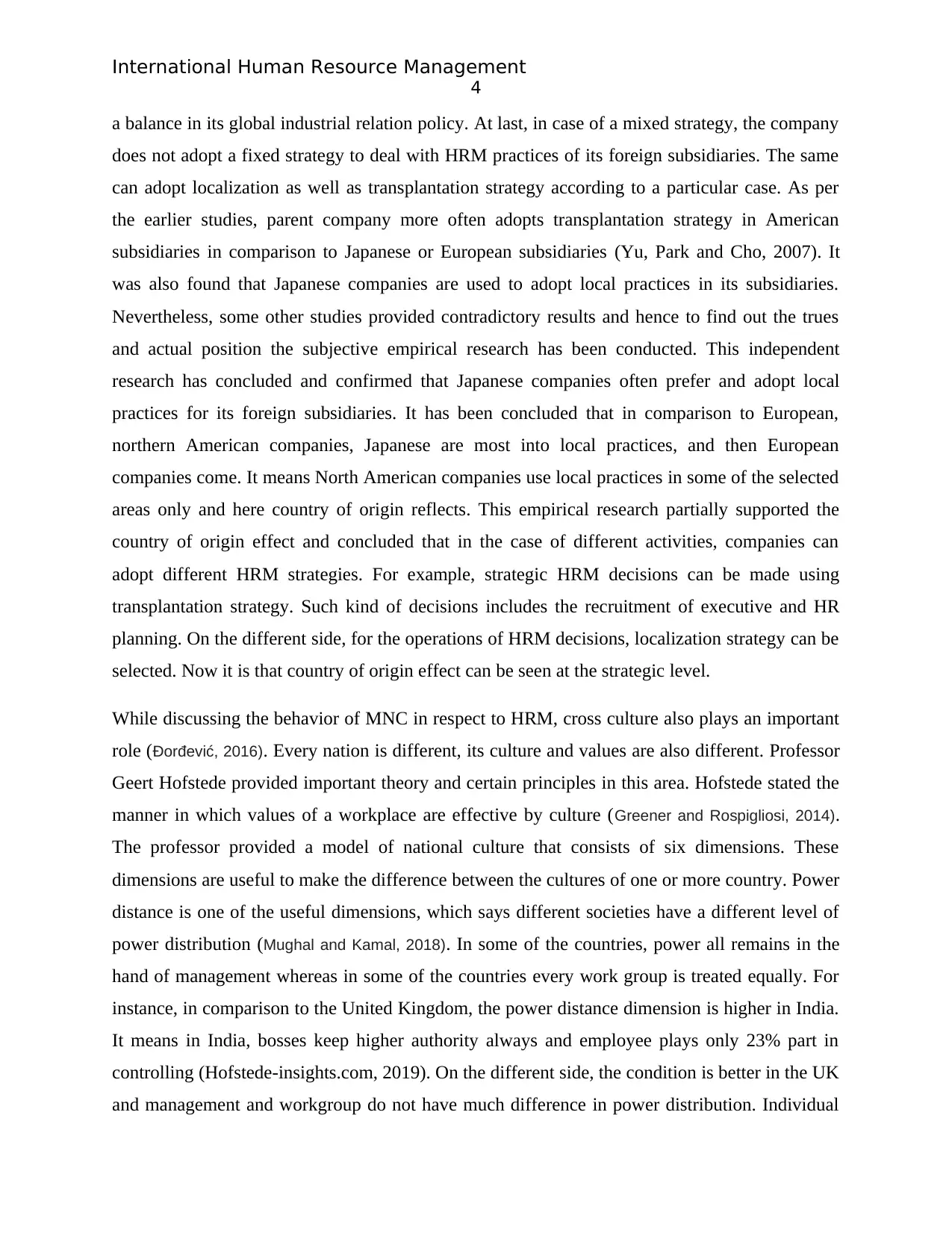
International Human Resource Management
4
a balance in its global industrial relation policy. At last, in case of a mixed strategy, the company
does not adopt a fixed strategy to deal with HRM practices of its foreign subsidiaries. The same
can adopt localization as well as transplantation strategy according to a particular case. As per
the earlier studies, parent company more often adopts transplantation strategy in American
subsidiaries in comparison to Japanese or European subsidiaries (Yu, Park and Cho, 2007). It
was also found that Japanese companies are used to adopt local practices in its subsidiaries.
Nevertheless, some other studies provided contradictory results and hence to find out the trues
and actual position the subjective empirical research has been conducted. This independent
research has concluded and confirmed that Japanese companies often prefer and adopt local
practices for its foreign subsidiaries. It has been concluded that in comparison to European,
northern American companies, Japanese are most into local practices, and then European
companies come. It means North American companies use local practices in some of the selected
areas only and here country of origin reflects. This empirical research partially supported the
country of origin effect and concluded that in the case of different activities, companies can
adopt different HRM strategies. For example, strategic HRM decisions can be made using
transplantation strategy. Such kind of decisions includes the recruitment of executive and HR
planning. On the different side, for the operations of HRM decisions, localization strategy can be
selected. Now it is that country of origin effect can be seen at the strategic level.
While discussing the behavior of MNC in respect to HRM, cross culture also plays an important
role (Đorđević, 2016). Every nation is different, its culture and values are also different. Professor
Geert Hofstede provided important theory and certain principles in this area. Hofstede stated the
manner in which values of a workplace are effective by culture (Greener and Rospigliosi, 2014).
The professor provided a model of national culture that consists of six dimensions. These
dimensions are useful to make the difference between the cultures of one or more country. Power
distance is one of the useful dimensions, which says different societies have a different level of
power distribution (Mughal and Kamal, 2018). In some of the countries, power all remains in the
hand of management whereas in some of the countries every work group is treated equally. For
instance, in comparison to the United Kingdom, the power distance dimension is higher in India.
It means in India, bosses keep higher authority always and employee plays only 23% part in
controlling (Hofstede-insights.com, 2019). On the different side, the condition is better in the UK
and management and workgroup do not have much difference in power distribution. Individual
4
a balance in its global industrial relation policy. At last, in case of a mixed strategy, the company
does not adopt a fixed strategy to deal with HRM practices of its foreign subsidiaries. The same
can adopt localization as well as transplantation strategy according to a particular case. As per
the earlier studies, parent company more often adopts transplantation strategy in American
subsidiaries in comparison to Japanese or European subsidiaries (Yu, Park and Cho, 2007). It
was also found that Japanese companies are used to adopt local practices in its subsidiaries.
Nevertheless, some other studies provided contradictory results and hence to find out the trues
and actual position the subjective empirical research has been conducted. This independent
research has concluded and confirmed that Japanese companies often prefer and adopt local
practices for its foreign subsidiaries. It has been concluded that in comparison to European,
northern American companies, Japanese are most into local practices, and then European
companies come. It means North American companies use local practices in some of the selected
areas only and here country of origin reflects. This empirical research partially supported the
country of origin effect and concluded that in the case of different activities, companies can
adopt different HRM strategies. For example, strategic HRM decisions can be made using
transplantation strategy. Such kind of decisions includes the recruitment of executive and HR
planning. On the different side, for the operations of HRM decisions, localization strategy can be
selected. Now it is that country of origin effect can be seen at the strategic level.
While discussing the behavior of MNC in respect to HRM, cross culture also plays an important
role (Đorđević, 2016). Every nation is different, its culture and values are also different. Professor
Geert Hofstede provided important theory and certain principles in this area. Hofstede stated the
manner in which values of a workplace are effective by culture (Greener and Rospigliosi, 2014).
The professor provided a model of national culture that consists of six dimensions. These
dimensions are useful to make the difference between the cultures of one or more country. Power
distance is one of the useful dimensions, which says different societies have a different level of
power distribution (Mughal and Kamal, 2018). In some of the countries, power all remains in the
hand of management whereas in some of the countries every work group is treated equally. For
instance, in comparison to the United Kingdom, the power distance dimension is higher in India.
It means in India, bosses keep higher authority always and employee plays only 23% part in
controlling (Hofstede-insights.com, 2019). On the different side, the condition is better in the UK
and management and workgroup do not have much difference in power distribution. Individual
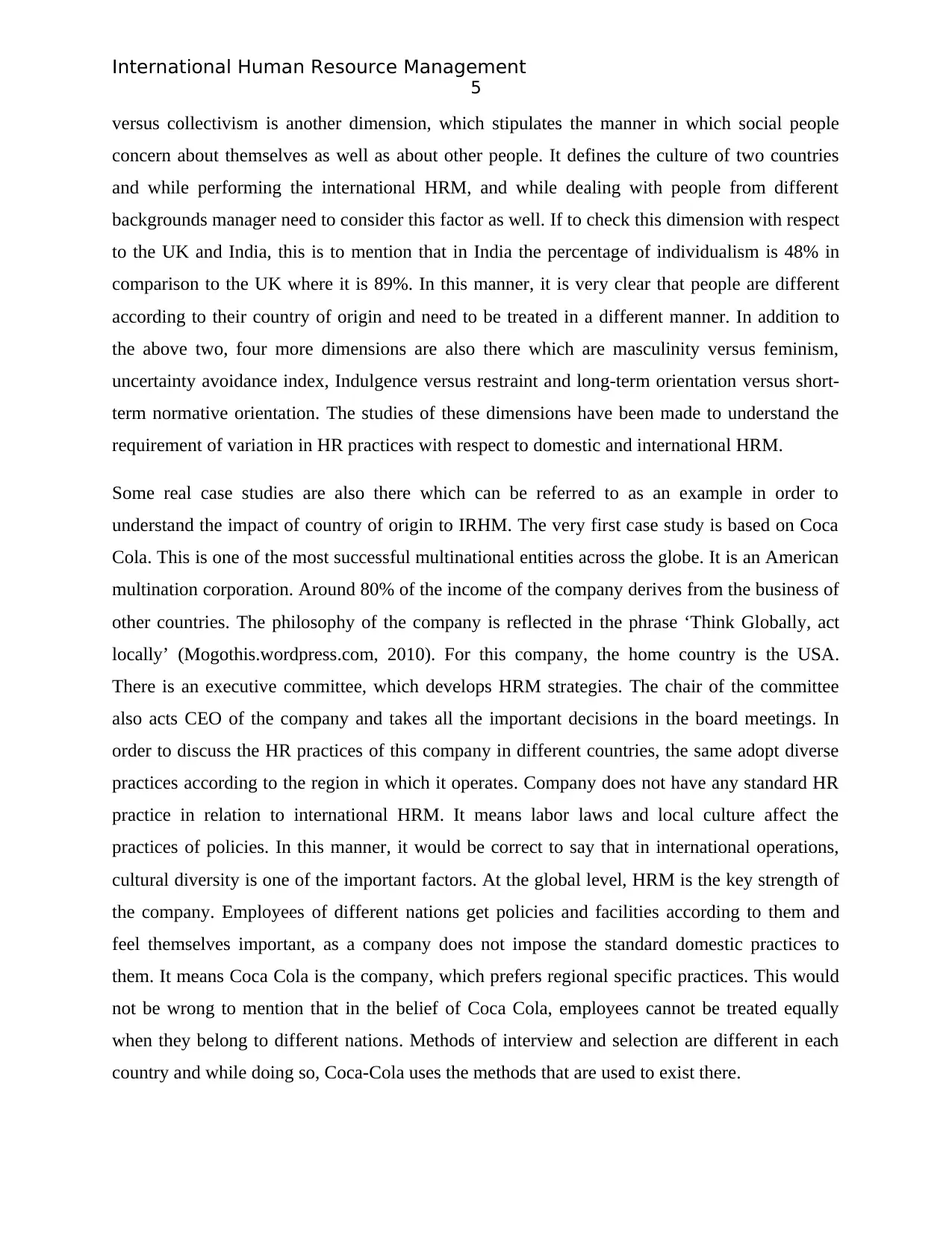
International Human Resource Management
5
versus collectivism is another dimension, which stipulates the manner in which social people
concern about themselves as well as about other people. It defines the culture of two countries
and while performing the international HRM, and while dealing with people from different
backgrounds manager need to consider this factor as well. If to check this dimension with respect
to the UK and India, this is to mention that in India the percentage of individualism is 48% in
comparison to the UK where it is 89%. In this manner, it is very clear that people are different
according to their country of origin and need to be treated in a different manner. In addition to
the above two, four more dimensions are also there which are masculinity versus feminism,
uncertainty avoidance index, Indulgence versus restraint and long-term orientation versus short-
term normative orientation. The studies of these dimensions have been made to understand the
requirement of variation in HR practices with respect to domestic and international HRM.
Some real case studies are also there which can be referred to as an example in order to
understand the impact of country of origin to IRHM. The very first case study is based on Coca
Cola. This is one of the most successful multinational entities across the globe. It is an American
multination corporation. Around 80% of the income of the company derives from the business of
other countries. The philosophy of the company is reflected in the phrase ‘Think Globally, act
locally’ (Mogothis.wordpress.com, 2010). For this company, the home country is the USA.
There is an executive committee, which develops HRM strategies. The chair of the committee
also acts CEO of the company and takes all the important decisions in the board meetings. In
order to discuss the HR practices of this company in different countries, the same adopt diverse
practices according to the region in which it operates. Company does not have any standard HR
practice in relation to international HRM. It means labor laws and local culture affect the
practices of policies. In this manner, it would be correct to say that in international operations,
cultural diversity is one of the important factors. At the global level, HRM is the key strength of
the company. Employees of different nations get policies and facilities according to them and
feel themselves important, as a company does not impose the standard domestic practices to
them. It means Coca Cola is the company, which prefers regional specific practices. This would
not be wrong to mention that in the belief of Coca Cola, employees cannot be treated equally
when they belong to different nations. Methods of interview and selection are different in each
country and while doing so, Coca-Cola uses the methods that are used to exist there.
5
versus collectivism is another dimension, which stipulates the manner in which social people
concern about themselves as well as about other people. It defines the culture of two countries
and while performing the international HRM, and while dealing with people from different
backgrounds manager need to consider this factor as well. If to check this dimension with respect
to the UK and India, this is to mention that in India the percentage of individualism is 48% in
comparison to the UK where it is 89%. In this manner, it is very clear that people are different
according to their country of origin and need to be treated in a different manner. In addition to
the above two, four more dimensions are also there which are masculinity versus feminism,
uncertainty avoidance index, Indulgence versus restraint and long-term orientation versus short-
term normative orientation. The studies of these dimensions have been made to understand the
requirement of variation in HR practices with respect to domestic and international HRM.
Some real case studies are also there which can be referred to as an example in order to
understand the impact of country of origin to IRHM. The very first case study is based on Coca
Cola. This is one of the most successful multinational entities across the globe. It is an American
multination corporation. Around 80% of the income of the company derives from the business of
other countries. The philosophy of the company is reflected in the phrase ‘Think Globally, act
locally’ (Mogothis.wordpress.com, 2010). For this company, the home country is the USA.
There is an executive committee, which develops HRM strategies. The chair of the committee
also acts CEO of the company and takes all the important decisions in the board meetings. In
order to discuss the HR practices of this company in different countries, the same adopt diverse
practices according to the region in which it operates. Company does not have any standard HR
practice in relation to international HRM. It means labor laws and local culture affect the
practices of policies. In this manner, it would be correct to say that in international operations,
cultural diversity is one of the important factors. At the global level, HRM is the key strength of
the company. Employees of different nations get policies and facilities according to them and
feel themselves important, as a company does not impose the standard domestic practices to
them. It means Coca Cola is the company, which prefers regional specific practices. This would
not be wrong to mention that in the belief of Coca Cola, employees cannot be treated equally
when they belong to different nations. Methods of interview and selection are different in each
country and while doing so, Coca-Cola uses the methods that are used to exist there.
⊘ This is a preview!⊘
Do you want full access?
Subscribe today to unlock all pages.

Trusted by 1+ million students worldwide
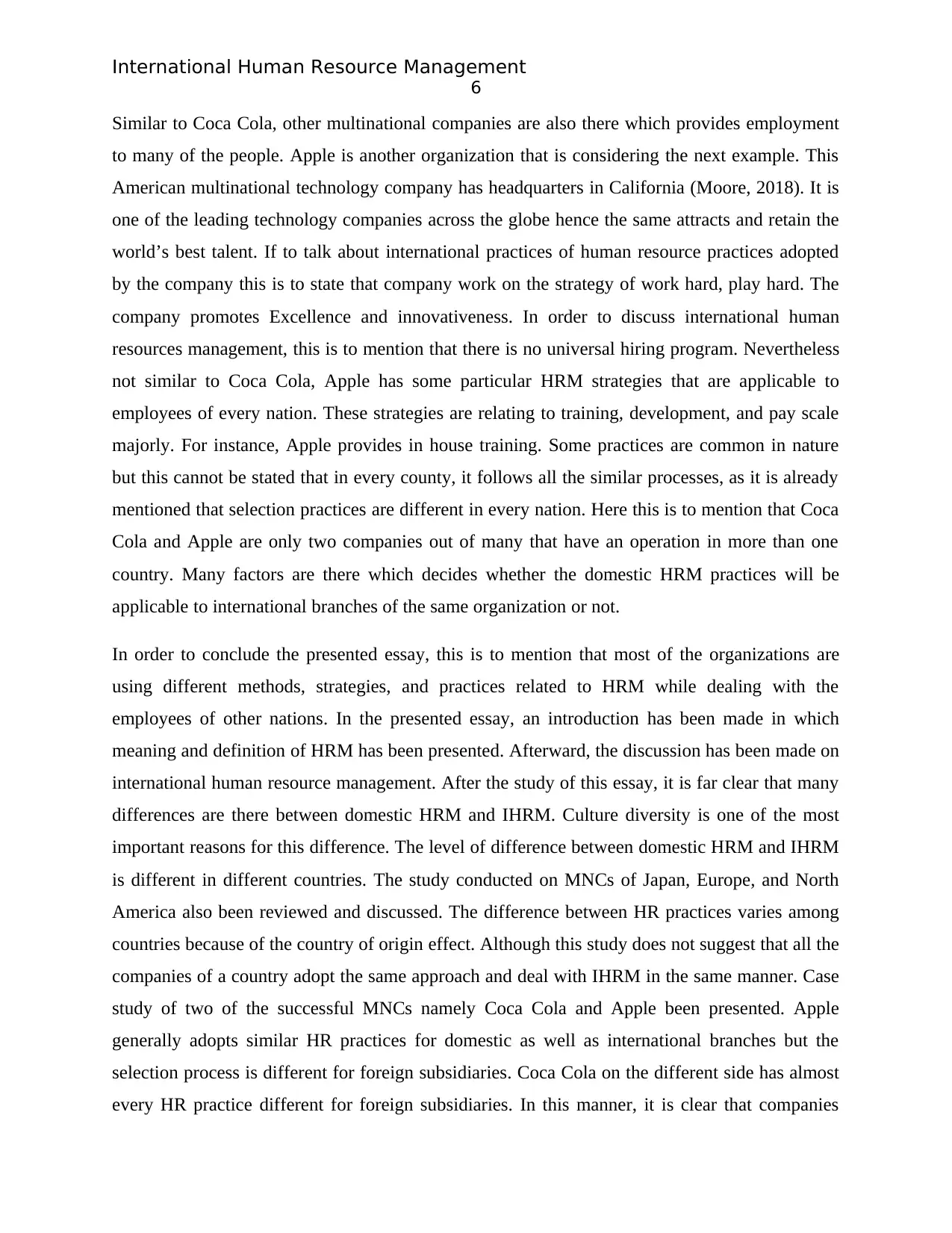
International Human Resource Management
6
Similar to Coca Cola, other multinational companies are also there which provides employment
to many of the people. Apple is another organization that is considering the next example. This
American multinational technology company has headquarters in California (Moore, 2018). It is
one of the leading technology companies across the globe hence the same attracts and retain the
world’s best talent. If to talk about international practices of human resource practices adopted
by the company this is to state that company work on the strategy of work hard, play hard. The
company promotes Excellence and innovativeness. In order to discuss international human
resources management, this is to mention that there is no universal hiring program. Nevertheless
not similar to Coca Cola, Apple has some particular HRM strategies that are applicable to
employees of every nation. These strategies are relating to training, development, and pay scale
majorly. For instance, Apple provides in house training. Some practices are common in nature
but this cannot be stated that in every county, it follows all the similar processes, as it is already
mentioned that selection practices are different in every nation. Here this is to mention that Coca
Cola and Apple are only two companies out of many that have an operation in more than one
country. Many factors are there which decides whether the domestic HRM practices will be
applicable to international branches of the same organization or not.
In order to conclude the presented essay, this is to mention that most of the organizations are
using different methods, strategies, and practices related to HRM while dealing with the
employees of other nations. In the presented essay, an introduction has been made in which
meaning and definition of HRM has been presented. Afterward, the discussion has been made on
international human resource management. After the study of this essay, it is far clear that many
differences are there between domestic HRM and IHRM. Culture diversity is one of the most
important reasons for this difference. The level of difference between domestic HRM and IHRM
is different in different countries. The study conducted on MNCs of Japan, Europe, and North
America also been reviewed and discussed. The difference between HR practices varies among
countries because of the country of origin effect. Although this study does not suggest that all the
companies of a country adopt the same approach and deal with IHRM in the same manner. Case
study of two of the successful MNCs namely Coca Cola and Apple been presented. Apple
generally adopts similar HR practices for domestic as well as international branches but the
selection process is different for foreign subsidiaries. Coca Cola on the different side has almost
every HR practice different for foreign subsidiaries. In this manner, it is clear that companies
6
Similar to Coca Cola, other multinational companies are also there which provides employment
to many of the people. Apple is another organization that is considering the next example. This
American multinational technology company has headquarters in California (Moore, 2018). It is
one of the leading technology companies across the globe hence the same attracts and retain the
world’s best talent. If to talk about international practices of human resource practices adopted
by the company this is to state that company work on the strategy of work hard, play hard. The
company promotes Excellence and innovativeness. In order to discuss international human
resources management, this is to mention that there is no universal hiring program. Nevertheless
not similar to Coca Cola, Apple has some particular HRM strategies that are applicable to
employees of every nation. These strategies are relating to training, development, and pay scale
majorly. For instance, Apple provides in house training. Some practices are common in nature
but this cannot be stated that in every county, it follows all the similar processes, as it is already
mentioned that selection practices are different in every nation. Here this is to mention that Coca
Cola and Apple are only two companies out of many that have an operation in more than one
country. Many factors are there which decides whether the domestic HRM practices will be
applicable to international branches of the same organization or not.
In order to conclude the presented essay, this is to mention that most of the organizations are
using different methods, strategies, and practices related to HRM while dealing with the
employees of other nations. In the presented essay, an introduction has been made in which
meaning and definition of HRM has been presented. Afterward, the discussion has been made on
international human resource management. After the study of this essay, it is far clear that many
differences are there between domestic HRM and IHRM. Culture diversity is one of the most
important reasons for this difference. The level of difference between domestic HRM and IHRM
is different in different countries. The study conducted on MNCs of Japan, Europe, and North
America also been reviewed and discussed. The difference between HR practices varies among
countries because of the country of origin effect. Although this study does not suggest that all the
companies of a country adopt the same approach and deal with IHRM in the same manner. Case
study of two of the successful MNCs namely Coca Cola and Apple been presented. Apple
generally adopts similar HR practices for domestic as well as international branches but the
selection process is different for foreign subsidiaries. Coca Cola on the different side has almost
every HR practice different for foreign subsidiaries. In this manner, it is clear that companies
Paraphrase This Document
Need a fresh take? Get an instant paraphrase of this document with our AI Paraphraser
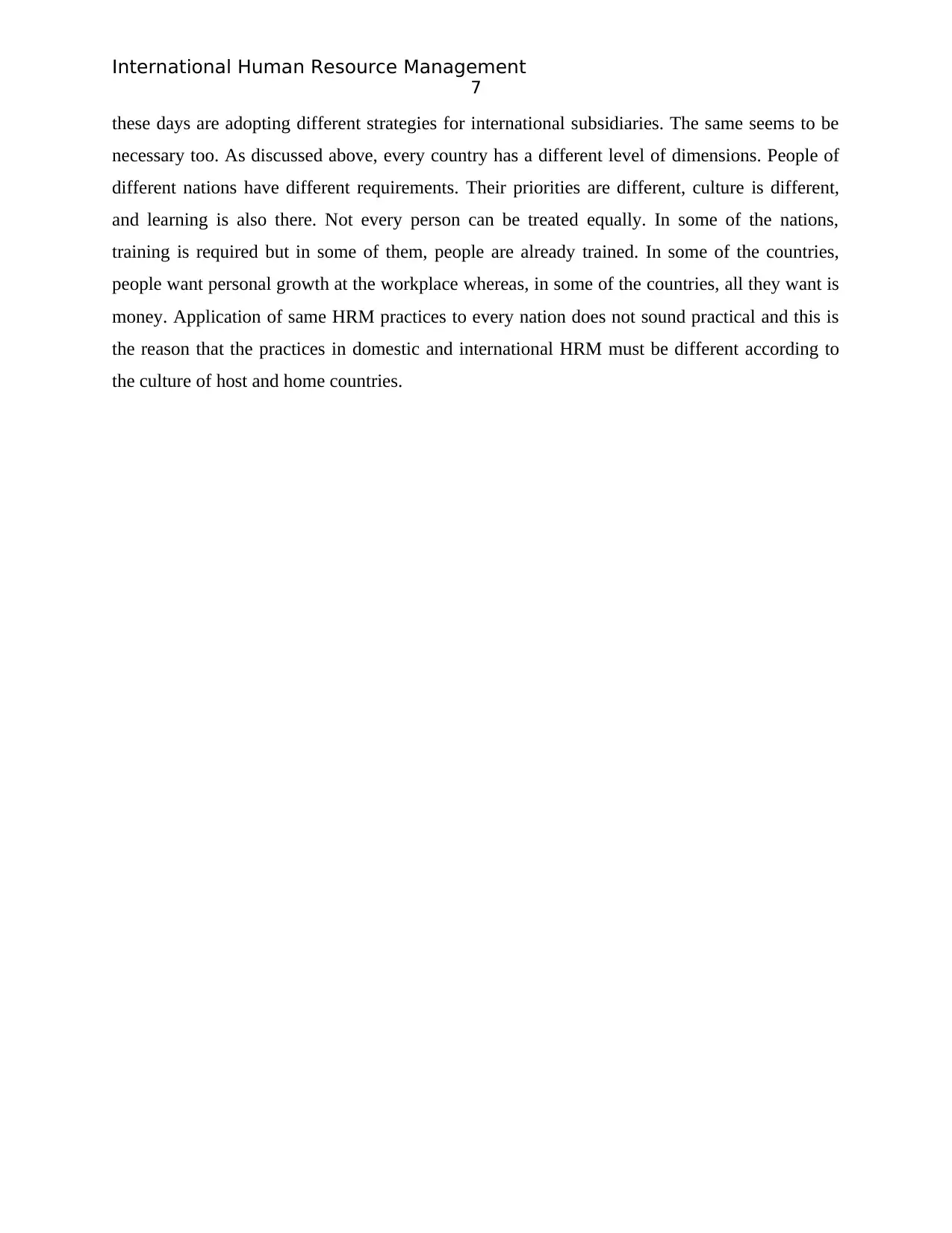
International Human Resource Management
7
these days are adopting different strategies for international subsidiaries. The same seems to be
necessary too. As discussed above, every country has a different level of dimensions. People of
different nations have different requirements. Their priorities are different, culture is different,
and learning is also there. Not every person can be treated equally. In some of the nations,
training is required but in some of them, people are already trained. In some of the countries,
people want personal growth at the workplace whereas, in some of the countries, all they want is
money. Application of same HRM practices to every nation does not sound practical and this is
the reason that the practices in domestic and international HRM must be different according to
the culture of host and home countries.
7
these days are adopting different strategies for international subsidiaries. The same seems to be
necessary too. As discussed above, every country has a different level of dimensions. People of
different nations have different requirements. Their priorities are different, culture is different,
and learning is also there. Not every person can be treated equally. In some of the nations,
training is required but in some of them, people are already trained. In some of the countries,
people want personal growth at the workplace whereas, in some of the countries, all they want is
money. Application of same HRM practices to every nation does not sound practical and this is
the reason that the practices in domestic and international HRM must be different according to
the culture of host and home countries.
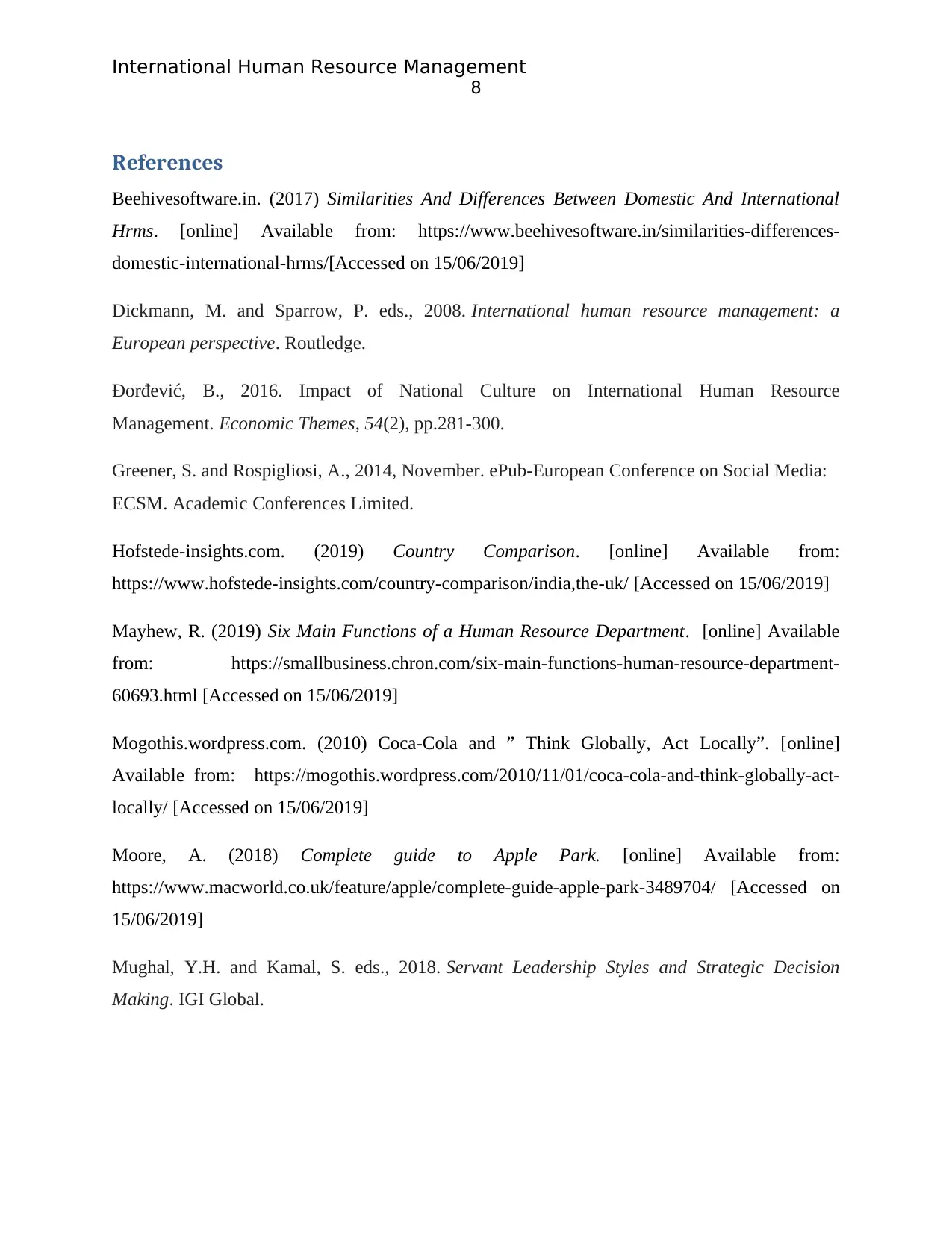
International Human Resource Management
8
References
Beehivesoftware.in. (2017) Similarities And Differences Between Domestic And International
Hrms. [online] Available from: https://www.beehivesoftware.in/similarities-differences-
domestic-international-hrms/[Accessed on 15/06/2019]
Dickmann, M. and Sparrow, P. eds., 2008. International human resource management: a
European perspective. Routledge.
Đorđević, B., 2016. Impact of National Culture on International Human Resource
Management. Economic Themes, 54(2), pp.281-300.
Greener, S. and Rospigliosi, A., 2014, November. ePub-European Conference on Social Media:
ECSM. Academic Conferences Limited.
Hofstede-insights.com. (2019) Country Comparison. [online] Available from:
https://www.hofstede-insights.com/country-comparison/india,the-uk/ [Accessed on 15/06/2019]
Mayhew, R. (2019) Six Main Functions of a Human Resource Department. [online] Available
from: https://smallbusiness.chron.com/six-main-functions-human-resource-department-
60693.html [Accessed on 15/06/2019]
Mogothis.wordpress.com. (2010) Coca-Cola and ” Think Globally, Act Locally”. [online]
Available from: https://mogothis.wordpress.com/2010/11/01/coca-cola-and-think-globally-act-
locally/ [Accessed on 15/06/2019]
Moore, A. (2018) Complete guide to Apple Park. [online] Available from:
https://www.macworld.co.uk/feature/apple/complete-guide-apple-park-3489704/ [Accessed on
15/06/2019]
Mughal, Y.H. and Kamal, S. eds., 2018. Servant Leadership Styles and Strategic Decision
Making. IGI Global.
8
References
Beehivesoftware.in. (2017) Similarities And Differences Between Domestic And International
Hrms. [online] Available from: https://www.beehivesoftware.in/similarities-differences-
domestic-international-hrms/[Accessed on 15/06/2019]
Dickmann, M. and Sparrow, P. eds., 2008. International human resource management: a
European perspective. Routledge.
Đorđević, B., 2016. Impact of National Culture on International Human Resource
Management. Economic Themes, 54(2), pp.281-300.
Greener, S. and Rospigliosi, A., 2014, November. ePub-European Conference on Social Media:
ECSM. Academic Conferences Limited.
Hofstede-insights.com. (2019) Country Comparison. [online] Available from:
https://www.hofstede-insights.com/country-comparison/india,the-uk/ [Accessed on 15/06/2019]
Mayhew, R. (2019) Six Main Functions of a Human Resource Department. [online] Available
from: https://smallbusiness.chron.com/six-main-functions-human-resource-department-
60693.html [Accessed on 15/06/2019]
Mogothis.wordpress.com. (2010) Coca-Cola and ” Think Globally, Act Locally”. [online]
Available from: https://mogothis.wordpress.com/2010/11/01/coca-cola-and-think-globally-act-
locally/ [Accessed on 15/06/2019]
Moore, A. (2018) Complete guide to Apple Park. [online] Available from:
https://www.macworld.co.uk/feature/apple/complete-guide-apple-park-3489704/ [Accessed on
15/06/2019]
Mughal, Y.H. and Kamal, S. eds., 2018. Servant Leadership Styles and Strategic Decision
Making. IGI Global.
⊘ This is a preview!⊘
Do you want full access?
Subscribe today to unlock all pages.

Trusted by 1+ million students worldwide
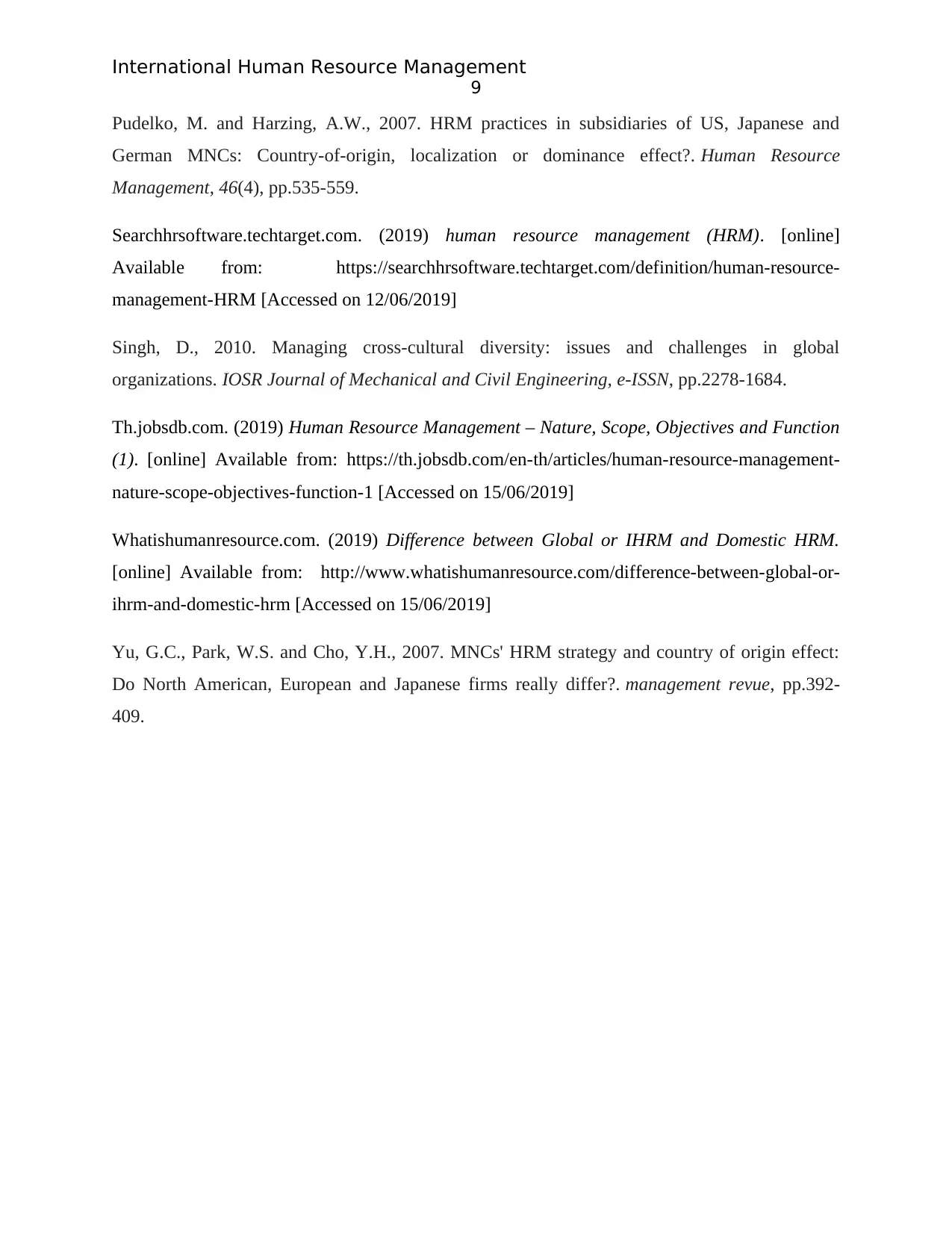
International Human Resource Management
9
Pudelko, M. and Harzing, A.W., 2007. HRM practices in subsidiaries of US, Japanese and
German MNCs: Country-of-origin, localization or dominance effect?. Human Resource
Management, 46(4), pp.535-559.
Searchhrsoftware.techtarget.com. (2019) human resource management (HRM). [online]
Available from: https://searchhrsoftware.techtarget.com/definition/human-resource-
management-HRM [Accessed on 12/06/2019]
Singh, D., 2010. Managing cross-cultural diversity: issues and challenges in global
organizations. IOSR Journal of Mechanical and Civil Engineering, e-ISSN, pp.2278-1684.
Th.jobsdb.com. (2019) Human Resource Management – Nature, Scope, Objectives and Function
(1). [online] Available from: https://th.jobsdb.com/en-th/articles/human-resource-management-
nature-scope-objectives-function-1 [Accessed on 15/06/2019]
Whatishumanresource.com. (2019) Difference between Global or IHRM and Domestic HRM.
[online] Available from: http://www.whatishumanresource.com/difference-between-global-or-
ihrm-and-domestic-hrm [Accessed on 15/06/2019]
Yu, G.C., Park, W.S. and Cho, Y.H., 2007. MNCs' HRM strategy and country of origin effect:
Do North American, European and Japanese firms really differ?. management revue, pp.392-
409.
9
Pudelko, M. and Harzing, A.W., 2007. HRM practices in subsidiaries of US, Japanese and
German MNCs: Country-of-origin, localization or dominance effect?. Human Resource
Management, 46(4), pp.535-559.
Searchhrsoftware.techtarget.com. (2019) human resource management (HRM). [online]
Available from: https://searchhrsoftware.techtarget.com/definition/human-resource-
management-HRM [Accessed on 12/06/2019]
Singh, D., 2010. Managing cross-cultural diversity: issues and challenges in global
organizations. IOSR Journal of Mechanical and Civil Engineering, e-ISSN, pp.2278-1684.
Th.jobsdb.com. (2019) Human Resource Management – Nature, Scope, Objectives and Function
(1). [online] Available from: https://th.jobsdb.com/en-th/articles/human-resource-management-
nature-scope-objectives-function-1 [Accessed on 15/06/2019]
Whatishumanresource.com. (2019) Difference between Global or IHRM and Domestic HRM.
[online] Available from: http://www.whatishumanresource.com/difference-between-global-or-
ihrm-and-domestic-hrm [Accessed on 15/06/2019]
Yu, G.C., Park, W.S. and Cho, Y.H., 2007. MNCs' HRM strategy and country of origin effect:
Do North American, European and Japanese firms really differ?. management revue, pp.392-
409.
1 out of 10
Related Documents
Your All-in-One AI-Powered Toolkit for Academic Success.
+13062052269
info@desklib.com
Available 24*7 on WhatsApp / Email
![[object Object]](/_next/static/media/star-bottom.7253800d.svg)
Unlock your academic potential
Copyright © 2020–2025 A2Z Services. All Rights Reserved. Developed and managed by ZUCOL.



